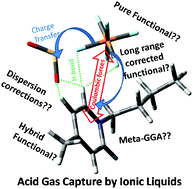Assessment of DFT methods for studying acid gas capture by ionic liquids
Abstract
For the first time, this work reports an analysis of the performance of Density Functional methods for studying acid gas capture (CO2 and SO2) by ionic liquids (ILs). The considered functionals were selected as representatives of the available families: pure GGA (PBE and BLYP), hybrid (PBE0 and B3LYP), hybrid meta-GGA (M06, M06-2X and M06-HF), long range corrected (LC-PBEPBE, CAM-B3LYP, ωB97X) and dispersion corrected (PBE-D2, B3LYP-D2 and ωB97XD). Likewise, HF and MP2 were also applied. Binding energies of cation–anion interacting pairs as well as IL–CO2 and IL–SO2 systems were calculated for a set of 54 ILs and compared against MP2/aug-cc-pvDZ. Unlike previously reported DFT benchmarks on ILs, which calculated binding energies through single point calculations on fixed geometries, properties in this work were calculated for geometries optimized at each theoretical level. DFT functionals that are suitable for describing ion–ion and ion–gas interactions were identified, considering both Coulombic forces and dispersion interactions. The reported results allowed us to infer relationships to the rational design of ILs for acid gas capture.


 Please wait while we load your content...
Please wait while we load your content...